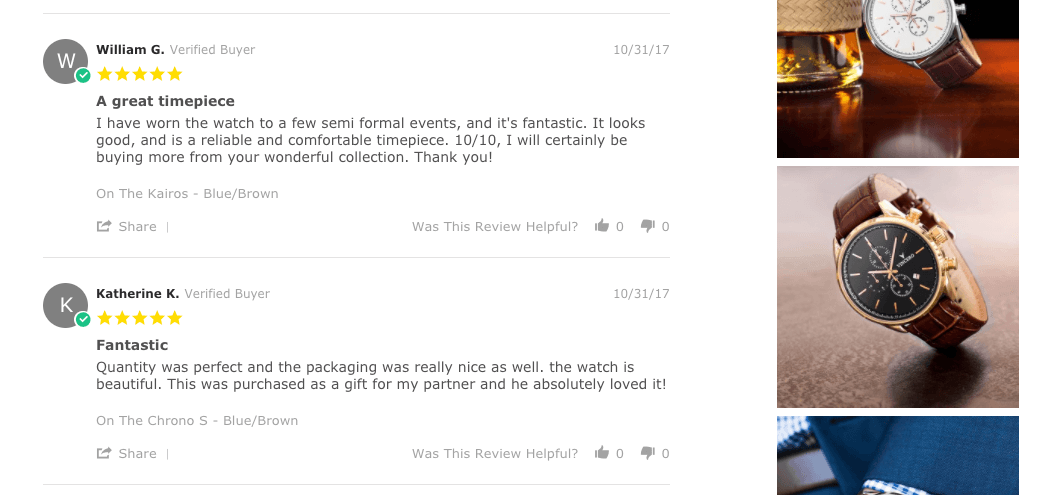
Every e-commerce brand wants to make a splash with its potential customers—and we all know the best way to accomplish that is through flashy marketing gimmicks, right?
Well, as valuable as marketing your B2C e-commerce brand may be, you may want to reconsider how much you prioritize it. Because all the marketing in the world isn’t going to do you much good if you sell a lousy product.
Customer dissatisfaction is a very real problem in B2C e-commerce. The Wall Street Journal reports that approximately one-third of all online purchases are returned to the retailer, with apparel and “big ticket” items being among the most likely to be returned.
But what is it that causes this staggeringly high return rate? What do B2C e-commerce companies need to do to ensure they don’t get overwhelmed in a wave of returned products?
For many brands, the answer lies in manufacturing.
In preparation for this post, I spoke with my friend Tim Nybo, co-founder of Vincero Collective. As someone who got his own e-commerce start with a watch brand, it was easy for me to connect with the concept behind Tim’s company—producing top-quality watches at an affordable price.
The most impressive thing about Vincero Collective though? Their return rate is a staggeringly low 1.2%—something they directly attribute to focusing on manufacturing over marketing their products first.
The dangers of a high return rate
On the surface, you might be tempted to brush aside product returns as an exaggerated problem. After all, every e-commerce company (especially apparel brands) will have those customers who plan to use generous return policies so they can try your product without actually paying for it.
Those people aren’t going to go away.
However, the real problem occurs when your marketing hypes up a product that ultimately fails to live up to customer expectations. Maybe it doesn’t do what your marketing claimed to do. Perhaps it breaks after only a few uses. Whatever the reason behind the manufacturing defect, overselling and under-delivering will always lead to a high return rate and … a short company lifespan.
This was the exact type of problem Tim and Vincero Collective hoped to avoid.
“Our group of co-founders worked in manufacturing for other watch companies for years before starting out on our own. We saw firsthand how mass-produced products fail the customer. The solution really comes from putting the customer first. If develop the mindset of ‘How can we make the products our customers really deserve,’ then you will naturally adopt and much more involved manufacturing process from start to finish.”

Returns have a significant impact on your e-commerce brand’s bottom line.
Customers who are dissatisfied with your product are unlikely to buy from you again, forcing you to invest more money in marketing. If you offer free shipping on returns, you may even lose money each time a customer buys and then decides to return a product.
The Harvard Business Review makes it very clear how keeping your customers affects your profitability: “Acquiring a new customer is anywhere from five to 25 times more expensive than retaining an existing one…increasing customer retention rates by 5% increases profits by 25% to 95%.”
If customers are frequently returning products because you’ve prioritized marketing over manufacturing, you could soon find your finances slipping into the red as you scramble to find new buyers.
Resolving common manufacturing issues
Naturally, one of the most obvious manufacturing concerns is when a damaged item arrives on the customer’s doorstep, or when the product itself fails to live up to the expectations established by the marketing. Returns and complaints are sure to follow.
In the long run, it doesn’t do you any good to over-promise and under-deliver. As previously mentioned, this will only increase how much money you need to spend to get new customers, keeping your business from becoming as profitable as it should be. Instead, you need to ensure that your products can live up to the marketing hype.
As Tim explains, enforcing strict quality standards has played a central role in helping Vincero Collective achieve high levels of customer satisfaction: “We visit our factories on a weekly basis and our team inspects every watch that comes off our line. It’s the only way there is to ensure a consistent level of quality. The reputation we’ve built with our customers by focusing on them first has ultimately been worth far more than any marketing campaign we’ve ever run.”

In the apparel industry, another common manufacturing problem is when an article of clothing doesn’t actually fit the customer. This issue is surprisingly widespread, especially when different manufacturers use different sizing standards.
The solution then, is to ensure that customers clearly understand your manufacturing specifications so they can make informed buying decisions. In this case, the issue isn’t quality—rather, it’s making sure that customers have the knowledge necessary so they can purchase the right product.

One example of an e-commerce brand that does this right is clothing retailer House of Fraser.
As part of the checkout process, buyers can input data on their height, weight, and clothing brands they usually wear, which the website’s algorithms then use to provide a recommended “True Fit” for the consumer. Enabling the customer to find a comfortable fit before they buy makes the manufacturing (and marketing) more effective and reduces returns.
Doing better
While improving the quality of your e-commerce products won’t necessarily eliminate every return, it can go a long way in ensuring that your items meet customer expectations and allow you to build a loyal consumer base—for Vincero Collective, this approach allowed them to grow into an 8-figure business in less than three years.
By placing a stronger emphasis on your product and supplying customers with helpful information, you can deliver on marketing promises and build a booming e-commerce brand.
Get the TNW newsletter
Get the most important tech news in your inbox each week.




